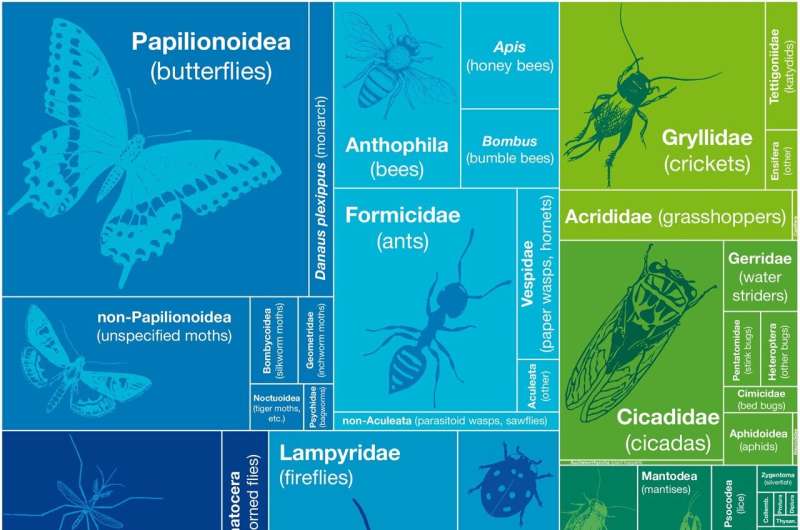This article has been reviewed according to Science X's editorial process and policies. Editors have highlighted the following attributes while ensuring the content's credibility:
fact-checked
peer-reviewed publication
trusted source
proofread
Haiku poems may shine a light on humans' relationship with insects, study suggests

Haiku poems have reflected humans' experiences in nature for hundreds of years, including observations of bugs and other wildlife. Recently, Penn State researchers analyzed which insects were mentioned the most in haiku—with butterflies, fireflies and singing insects such as crickets topping the list.
Haiku are three-line poems with five syllables in the first and third lines, and seven syllables in the second line.
In their study of nearly 4,000 haiku, published in the journal PLOS ONE, the researchers also found that aquatic arthropods—such as caddisflies, stoneflies and fishflies—were mentioned the least.
Corresponding author Andrew Deans, professor of entomology in the College of Agricultural Sciences and director of the college's Frost Entomological Museum, said the findings shine a light on the insects that inspire emotion and awe in humans the most—and the insects that don't get as much attention as they should.
"I think what we uncovered here are some opportunities for better outreach about the importance and relevance of insects, and in particular, focusing on those groups that provide a big influence on the world around us," Deans said. "For example, aquatic arthropods were almost never mentioned, so perhaps there's an opportunity for more education about them."
Deans said he was inspired to conduct the study by recent reports about insect decline worldwide. As scientists have discussed the potential impacts of this decline—such as reductions in plant pollination and gaps in the food chain—Deans said he was also curious about whether the declines would be reflected in art.
"We thought that maybe over time, there would be a change in tone or emotion in relation to insects that would be represented in these poems," Deans said. "Haiku are short, each representing a moment in nature, and we thought they could be a proxy for understanding how humans see and interact with insects, and which behaviors and aspects of insect biology that people tend to notice.
Co-author Laura Porturas, assistant curator at the Frost Entomological Museum, said they also were hoping to gain insights that would help them better communicate with the public.
"Sometimes it's difficult to talk with people about insects because their initial reaction is 'ew, creepy,'" Porturas said. "We were interested in learning which insects and what aspects of their biology have good emotions associated with them, because that would make it easier to talk to people about why insects are important and all the beneficial things they do in our ecosystem."
For the study, the researchers assembled a data set of 3,894 haiku written around the world by 1,248 individual poets between 1549 and 2022. About one third of the poems were sourced from the Hexapod Haiku Challenge, an annual poetry contest sponsored by the Frost Museum and specifically focused on insect-related haiku. The 2024 contest is accepting entries until June 15.
The researchers then used linguistic software to analyze the poems for the types of insects that were mentioned, different traits such as types of movement or sounds, and tone and emotion, among other factors.
In total, the researchers found that at least 99 families of arthropods, in 28 orders, were represented in the poems. The eight orders that were most commonly referenced were Lepidoptera, which includes butterflies and moths; Hymenoptera, which includes wasps, bees and ants; Diptera, which includes mosquitos and hoverflies; Coleoptera, which includes beetles; Araneae, which includes spiders; Orthoptera, which includes grasshoppers and crickets; Hemiptera, which includes cicadas; and Odonata, which includes dragonflies.
"Many of these insects, like butterflies, were found in haiku going back to the 1500s, so they were commonly referenced throughout time," Deans said. "Whereas spiders were also common, but we didn't see them written about until the 1950s. So, some were mentioned consistently throughout time, and others only recently. Bees, wasps and related insects also seem to be seen much more recently."
The researchers also tracked which traits were referenced, with the most common being those related to ecology, like habitat and the time of day; behavior, especially sound production; physical traits, especially color; and movement, especially flight.
Porturas said they used the findings to enhance this year's Hexapod Haiku Challenge. Participants are allowed to submit an additional haiku if they participated in the special aquatic arthropods challenge, or already submitted a haiku that specifically mentions aquatic arthropods.
"We encouraged people to go out and observe stream and pond insects and write a haiku about their experience," she said. "Hopefully, we'll get more people engaged in learning about these important insects and spending time in those habitats."
Deans said that in the future, he and Porturas plan to conduct additional studies, such as those with larger bodies of text that may allow for broader, stronger conclusions about how different arthropods are perceived by the public.
More information: Andrew R. Deans et al, Diversity and complexity of arthropod references in haiku, PLOS ONE (2024). DOI: 10.1371/journal.pone.0298865
Journal information: PLoS ONE
Provided by Pennsylvania State University



















